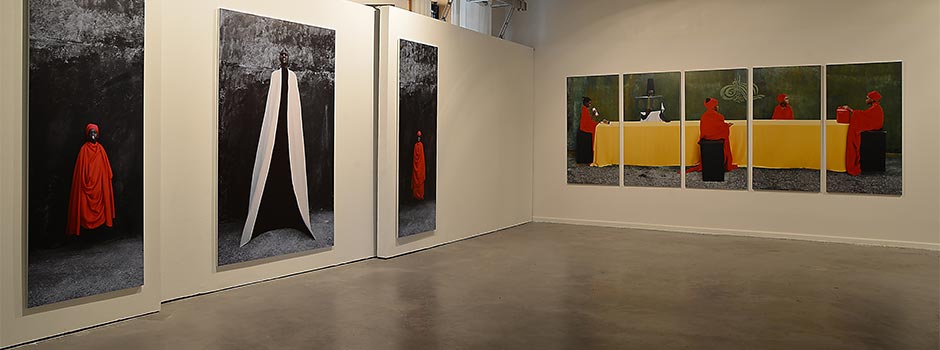
The Stimultania Gallery (April 11 - June 16, 2013) ‘The Mystic Black Body’, Photographs by Maïmouna Guerresi
Jun 24, 2013 Exhibition

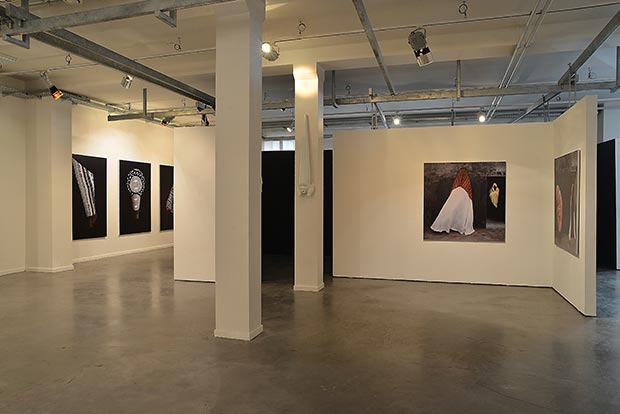 Installation view / © Maïmouna Guerresi, Courtesy of the Photo & Contemporary Gallery, Turin
Installation view / © Maïmouna Guerresi, Courtesy of the Photo & Contemporary Gallery, Turin
A veteran of the Italian art scene, Guerresi was known in the 1980s for the conceptual feminist work that she exhibited internationally, including at the Venice Biennale and Documenta. An encounter with the Senegalese Murid community in 1991, however, profoundly transformed her art and life: she married a member, had a daughter and was immersed in the mystical tradition of West African Islam. As the “The Mystic Black Body†exhibit attests, the experience continues to nourish and inform her art to this day.
The monumental colour photographs displayed from the Giant, Minaret and Warda Arusa series exert a strange magnetic pull on the spectator. Haunting and powerful, they invite one into a world in which the visible and invisible have lost their borders and coalesce.
Enigmatic subjects wearing garments the artist designs and sews herself strike hieratic poses. In the photographs from the Minaret series, the tall or large patterned textile hats Guerresi has fashioned become sculpture. Making up almost the totality of the image, they are also effectively the subject matter. In each photograph, the face beneath the hat —although not the person’s presence— is obscured, the cloth sculptures appearing as ciphers of something we instantly recognize but cannot quite identify.
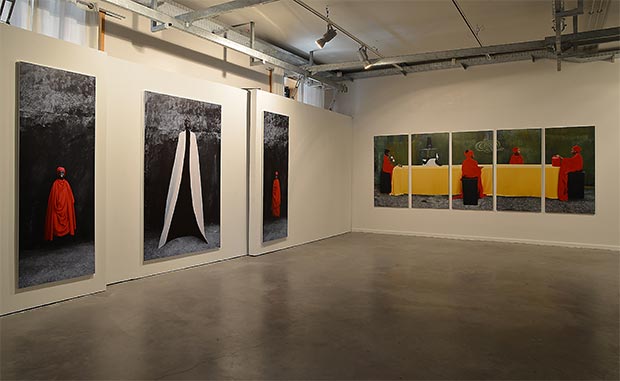 Installation view / © Maïmouna Guerresi, Courtesy of the Photo & Contemporary Gallery, Turin
Installation view / © Maïmouna Guerresi, Courtesy of the Photo & Contemporary Gallery, Turin
A surreal and symbolic dimension underwrites all of Guerresi’s work, even in narrative-driven pieces such as “Student and Teacherâ€. Echoes of past and present Western artistic and mystical traditions are evident in her art; however, post-1991, it is overwhelmingly inspired by West African culture and Sufism. The artist’s use of the void as an aesthetic strategy and signifier is reminiscent of Islamic art more generally. In “Mother Minaret†from the Giant series, a sole, towering figure stands against an overcast sky in which the chalk-drawn outline of a minaret appears on the painterly backdrop wall. The young girl looks downward, a median white line adorning her face. Her white veil covers her hair and falls to the ground, draping in lieu of her body, the rich black space evoking both door and tower that her body has become. These seeming gaps in representation breathe meaning into Guerresi’s giants analogous to the full stop punctuation mark whose silence consolidates the sense of a sentence. In “Genitilla al-Wiladaâ€, the woman’s abdomen suggests an entire cosmos or galaxy. The gendered metaphor of the framed circular emptiness begetting bubbles is unmistakable.
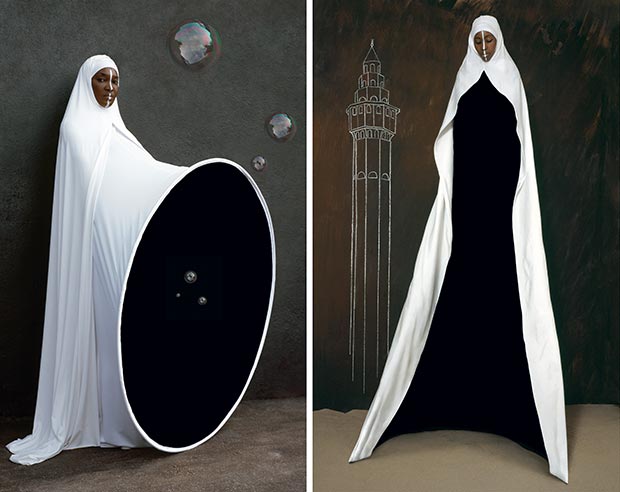 Left image: Genitilla al-Wilada, 2007, Lambda print on aluminum, 200 x 125 cm / Right image: Mother-Minaret, 2007, Lambda print on aluminum, 200 x 125 cm / Both images: © Maïmouna Guerresi, courtesy of the Photo & Contemporary Gallery, Turin
Left image: Genitilla al-Wilada, 2007, Lambda print on aluminum, 200 x 125 cm / Right image: Mother-Minaret, 2007, Lambda print on aluminum, 200 x 125 cm / Both images: © Maïmouna Guerresi, courtesy of the Photo & Contemporary Gallery, Turin
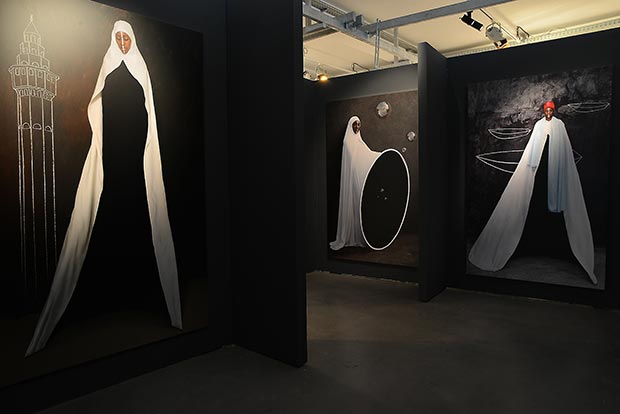 Installation view / © Maïmouna Guerresi, Courtesy of the Photo & Contemporary Gallery, Turin
Installation view / © Maïmouna Guerresi, Courtesy of the Photo & Contemporary Gallery, Turin
The Giant series also features men. In “Ibrahimâ€, a man of African descent is looking to his left, draped in a cerulean blue and white woven long scarf and red cap, both brilliant and crisp in contrast to the grey, painted background. In “Felukaâ€, the subject looks straight at the spectator, a white line adorning his face. His faded pastel blue scarf and long white robe frame the black tipi-shaped cavern-like space that, paradoxically, appears to symbolize his being. Three feluccas are drawn on the wall behind him. Simplified to their barest outline and surrounded by calligraphic inscriptions in Arabic, the small boats are transformed into portentous pictographic signs. In Guerresi’s vision, men like women straddle real and metaphorical terrains with evident ease and navigate a weightless world in which matter and space coincide, plotted unequivocally, akin to modern physics, as different manifestations of the same thing. These photographs are equally astounding on a technical level. They are inherently low-tech, the artist creating their effects solely through composition and props and not through image altering software.
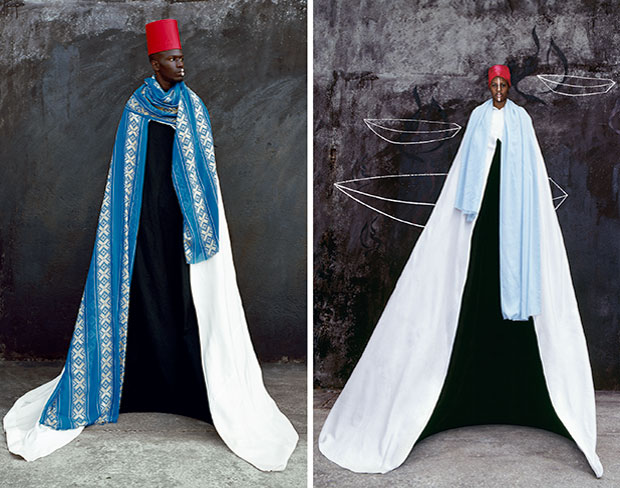 Left image: Ibrahim, 2007, Lambda print on aluminum, 200 x 125 cm / Right image: Faluka, 2010, Lambda print on aluminum, 200x125cm / Both images: © Maïmouna Guerresi, courtesy of the Photo & Contemporary Gallery, Turin
Left image: Ibrahim, 2007, Lambda print on aluminum, 200 x 125 cm / Right image: Faluka, 2010, Lambda print on aluminum, 200x125cm / Both images: © Maïmouna Guerresi, courtesy of the Photo & Contemporary Gallery, Turin
Guerresi works in several media. In addition to photography, she also produces videos, installations and sculpture. “Infinity Sound†included in the Strasbourg show consists of two small sleek white identical monochrome sculptures facing each other. Each depicts a face flanked by delicate hands: the eyes are covered with a veil while the mouth is open as if to speak. The echoing mouths connect the two busts through the invisible thread they trace across the gallery, simultaneously claiming the performative and the non-visual element of sound as part of the piece. It is again space, albeit here tangible physical space, that constitutes the operative factor actually producing the installation. Guerresi possesses an uncanny capacity to visually enact worlds charged with meaning but ones whose visuality defies any equivalent verbalization. It is this ability along with that of marrying culturally different artistic and spiritual traditions as well as references to high and low culture that make Guerresi’s post-secular rather than postmodern art singular.
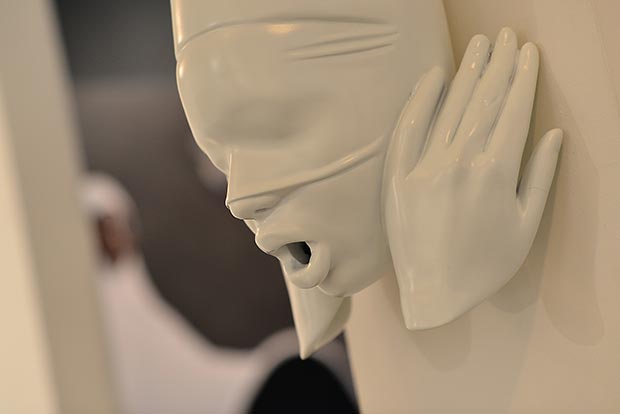 Infinity Sound, 2010, Resin, mirror. 120 x 25 x 30 cm and 120 x 28 x 32 cm / © Maïmouna Guerresi
Infinity Sound, 2010, Resin, mirror. 120 x 25 x 30 cm and 120 x 28 x 32 cm / © Maïmouna Guerresi
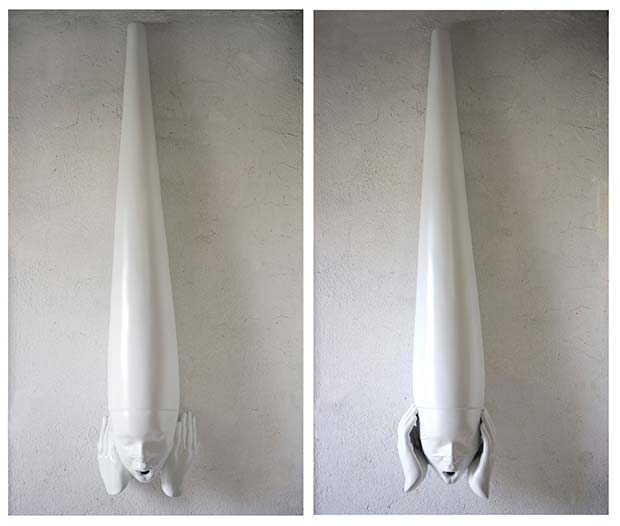 Infinity Sound - Sufi Urlanti, 2010, Resin, mirror. 120 x 25 x 30 cm and 120 x 28 x 32 cm / © Maïmouna Guerresi
Infinity Sound - Sufi Urlanti, 2010, Resin, mirror. 120 x 25 x 30 cm and 120 x 28 x 32 cm / © Maïmouna Guerresi
Maïmouna Guerresi is also currently a featured artist of the International Museum of Women’s online exhibit “Muslima†curated by Samina Ali. As a media partner of the IMOW show, Islamic Arts Magazine is happy to present another of its artists.
Comments
Add a comment